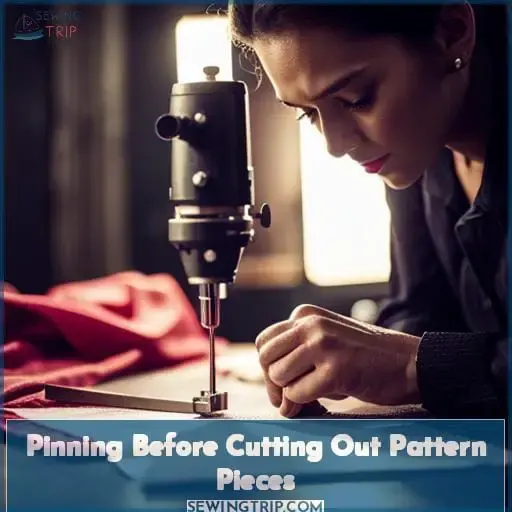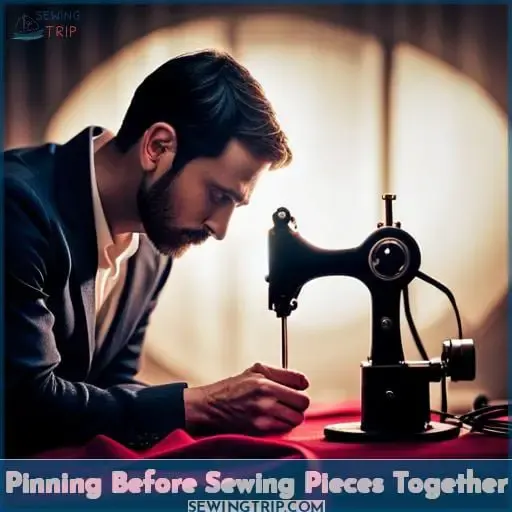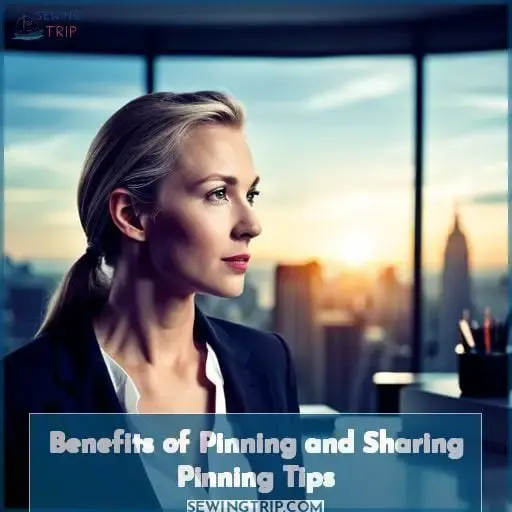This site is supported by our readers. We may earn a commission, at no cost to you, if you purchase through links.

Pinning not only helps with accuracy when cutting out pattern pieces but also strengthens seams and keeps fabric from shifting while stitching together. We will go over tips on proper pin placement, alternative methods to using pins, as well as the advantages of sharing your own pinning techniques with others.
So get ready for success – start learning about smart people who don’t skip pinning today!
Table Of Contents
Key Takeaways
- Pinning is crucial in sewing for accuracy and faster sewing speed.
- Using the right pins, such as 1.5-inch pins with brightly colored balls on top, and pinning parallel to cut lines at least 1/2 inch away from the edges of pattern pieces, helps achieve a beautiful and lasting creation.
- Extra pins are needed around corners and notch marks, and ballpoint pins should be used for knit fabrics.
- Magnetic pin holders offer an efficient and organized way to work with fabric, saving time and energy.
Importance of Pinning in Sewing
Pinning is an essential step in sewing that helps ensure a beautiful, lasting creation – so don’t cut corners and take the time to do it right! It’s important to use the proper pinning techniques for different fabric types and pin types.
When cutting pattern pieces from larger pieces of fabric, precision placement of pins will help prevent shifting or pulling. An alternative to hand-pinning is using a rotary cutter and mat; however, some people prefer traditional methods due to greater accuracy with curved shapes.
Place pins parallel (1/2 inch away) along edges when working with pattern pieces, perpendicular at seams when joining two pieces together before sewing them up, around corners or near notch marks if needed.
Taking extra time here ensures better quality results later: trust us – smart people always remember this critical step!
Pinning Before Cutting Out Pattern Pieces
You can save time and energy by strategically placing pins before you cut out pattern pieces, creating a stable starting point for your sewing project.
Consider the size of the pin: a 1.5-inch pin with bright-colored balls on top is recommended.
Also, think about fabric types when choosing marking tools like chalk or an ironing technique to mark grain line marks.
Finally, be sure to drop in extra pins around corners and notch marks. This takes some extra time but helps ensure faster sewing speed later!
Pinning correctly prioritizes accuracy while also allowing projects to flow more quickly once it’s complete.
Tips for Proper Pin Placement
Pinning correctly is essential to achieving the best results when sewing. To ensure accuracy, it’s important that pins are placed parallel to cut lines and at least 1/2 inch away from edges of pattern pieces.
Additionally, more pins should be used around corners and notch marks for extra stability.
Parallel to Cut Lines
When cutting out pattern pieces, make sure pins are placed parallel to the cut lines and 1/2 inch away from fabric edges for a more precise finish. Use double-ended arrows, 5-inch pins with bright colored balls on top, magnetic pin holders, and other time-saving tips for the best results.
Distance From Edges
By keeping your pins 1/2 inch away from the edges of fabric, you can save a significant amount of time when cutting. Choose 5-inch pins with brightly colored balls on top for easy visibility and to ensure accuracy.
A magnetic pin holder is an excellent alternative to standard pin cushions, as it makes retrieving and replacing individual pins much faster than manual methods.
More Pins for Corners and Notch Marks
For better accuracy and precision, use extra pins when working with corners and notch marks. Pin sizes should be 5 inches for maximum visibility. Use pin types that have brightly colored balls on top to make it easier to spot them during cutting.
Pay special attention to the corner of your pattern piece as well as the selvage edge of your fabric. These areas may require additional pins on top of those placed at regular intervals along the cut lines.
Don’t forget a magnetic pin holder or cushion, which will help you quickly remove and replace individual pins without having to search through piles! Make sure you place all pinned pieces securely onto the top of your cutting mat before beginning any sewing work for an improved finished product!
Pinning Before Sewing Pieces Together
Before taking up the needle and thread, it’s paramount to properly pin fabric pieces together. Pins should be placed perpendicular to seam edges for optimal alignment and stability; ballpoint pins are best when dealing with knit fabrics in order to avoid snagging.
Magnetic pin holders serve as an alternate option that allows you to easily find pins without them spilling out all over the place.
Perpendicular Placement to Seam Edges
When sewing pieces together, make sure to place your pins perpendicular to the seam edges for extra stability. Pinning types, tools, and techniques vary. However, using 1.5-inch pins with bright-colored balls on top is ideal for best results.
Ballpoint pins should be used when working with knit fabrics as they’re less likely to snag fabric threads.
Using Ballpoint Pins for Knit Fabrics
You’ll want to use ballpoint pins for knit fabrics to prevent snagging and ensure your seams stay intact. These are more suitable than standard pins as they create less friction when running along the yarns.
For best results, opt for 1.5-inch pins with bright-colored balls on top, which will help you easily identify them while stitching!
When working with patterns that require seam allowances or tailor tacks, using the correct gauge swatches and yarn weights is essential.
With a small commission of time invested beforehand, you can guarantee an even better finished product in the end.
Alternative to Pinning – Magnetic Pin Holders
An alternative to pinning, magnetic pin holders offer an efficient and organized way to work with your fabric. With magnet strength that holds pins securely in place, you can easily select the right type for each project.
Benefits of Pinning and Sharing Pinning Tips
Pinning your pieces together before sewing provides many benefits, so don’t skimp on this crucial step—it’s a no-brainer! Pinning prevents fabric from shifting and pulling, which can cause problems with the finished product.
Alternatives to pinning include using a rotary cutter or mat for precision cutting. Selecting the right type of pins is essential. Ideal for most fabrics are 1.5-inch pins with bright-colored balls on top.
When dealing with knit fabrics, ballpoint pins should be used to avoid snagging.
Magnetic pin holders offer an easy way to store and locate your pins without them spilling out all over the place.
So remember these tips when tackling any project: invest in quality tools like magnetic holders and select appropriate types of pincushions depending on fabric type.
Frequently Asked Questions (FAQs)
What types of fabrics should I use pins with?
Pins are essential for fabrics like leather and denim, but ballpoint pins should be used on knits to prevent snagging.
What is the best type of pin to use?
Using the best pins for your fabric will ensure a perfect finish. Look for ballpoint pins with brightly colored balls on top,
Are there any alternatives to pinning?
You don’t have to pin! A rotary cutter and mat can be used instead, allowing you to cut out pattern pieces with precise accuracy. Magnetic pin holders make it easier too – just slide the pins in for safe storage! With a few handy tools, time-consuming tasks like pinning can become a breeze.
How can I make sure I’m pinning accurately?
Pin accurately by using 5-inch pins with a bright ball on top. Place them parallel to cut lines and perpendicular to seam edges. Ballpoint pins should be used for knits, and use extra ones around corners or notch marks.
What are some tips for sewing faster?
Staggeringly fast sewing awaits you! Utilize ballpoint pins for knits, magnetic pin holders instead of cushions, and add extra pins around corners. Keep cut lines parallel to 1/2 inch from edges when cutting out pattern pieces. Place perpendicular pins when joining pieces together before sewing – the key to a successful project! Learn more in the article: How to Sew Faster.
Conclusion
Pinning is an essential part of the sewing process that should not be overlooked. Not only does it help provide a secure hold for your fabric, but it also helps ensure a better finished product. For example, one seamstress discovered that pinning her pieces together before sewing them made a world of difference when it came to the fit of her garment.











